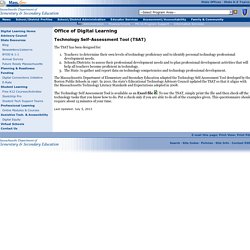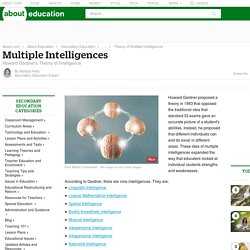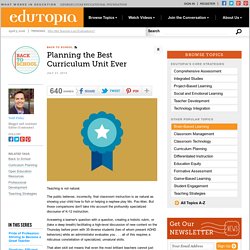

Instruction - SAS. Why we need to change the teacher vs. tech narrative. Complete Parent Teacher Communications Solution - ClassTag. Technology Self-Assessment Tool (TSAT) - Office of Digital Learning. The TSAT has been designed for: Teachers: to determine their own levels of technology proficiency and to identify personal technology professional development needs.

Schools/Districts: to assess their professional development needs and to plan professional development activities that will help all teachers become proficient in technology. The State: to gather and report data on technology competencies and technology professional development. The Massachusetts Department of Elementary and Secondary Education adapted the Technology Self-Assessment Tool developed by the Boston Public Schools in 1997. In 2010, the state's Educational Technology Advisory Council updated the TSAT so that it aligns with the Massachusetts Technology Literacy Standards and Expectations adopted in 2008.
The Technology Self Assessment Tool is available as an Excel file . "Education Is Not the Filling of a Pail, But the Lighting of a Fire" Block Scheduling Teaching Strategies. Howard Gardner's Theory of Intelligence. Howard Gardner proposed a theory in 1983 that opposed the traditional idea that standard IQ exams gave an accurate picture of a student's abilities.

Instead, he proposed that different individuals can and do excel in different areas. These idea of multiple intelligences expanded the way that educators looked at individual students strengths and weaknesses. According to Gardner, there are nine intelligences. They are: Traditionally, teachers tend to focus on the first two of these intelligences. Planning the Best Curriculum Unit Ever. Teaching is not natural.

The public believes, incorrectly, that classroom instruction is as natural as showing your child how to fish or helping a nephew play Ms. Pac-Man. But those comparisons don't take into account the profoundly specialized discourse of K-12 instruction. Answering a learner's question with a question, creating a holistic rubric, or (take a deep breath) facilitating a high-level discussion of new content on the Thursday before prom with 35 diverse students (two of whom present ADHD behaviors) while an administrator evaluates you . . . all of this requires a ridiculous constellation of specialized, unnatural skills.
That alien skill set means that even the most brilliant teachers cannot just wing it. While the public has no idea how much mental muscle curriculum planning requires, corporations that sell education materials do know. Because what works in one classroom often won't work the next period, flexibility, intuition, and judgment calls by instructors are needed. NEPPeerObsFeedbackProtocol.pdf.
Unexpected Tools That are Influencing the Future of Education. Mia Christopher Some big education issues have been making headlines, including how many and what kind of standardized tests should be used in education, implementation of Common Core State Standards and the Vergara ruling in California challenging teacher tenure.

But many educators continue to focus on the more personal issues behind these headlines: how to improve their craft, serve students better, nurture well-rounded, emotionally intelligent students and make educational change in more fundamental ways. Teachers have long known that struggles in the classroom are often a reflection of society as much as of academic ability. And beyond the many challenges related to rising poverty rates, there is the uniquely confusing moment in which society finds itself. Around the globe, economies are shifting away from machine-focused industries and toward human-powered creative industries. Saying students should drive their own learning is much easier than helping them do it. Can Students Have Too Much Tech? Photo PRESIDENT OBAMA’s domestic agenda, which he announced in his State of the Union address this month, has a lot to like: health care, maternity leave, affordable college.
But there was one thing he got wrong. As part of his promise to educate American children for an increasingly competitive world, he vowed to “protect a free and open Internet” and “extend its reach to every classroom and every community.” More technology in the classroom has long been a policy-making panacea. But mounting evidence shows that showering students, especially those from struggling families, with networked devices will not shrink the class divide in education.
In the early 2000s, the Duke University economists Jacob Vigdor and Helen Ladd tracked the academic progress of nearly one million disadvantaged middle-school students against the dates they were given networked computers. In fact, the students’ academic scores dropped and remained depressed for as long as the researchers kept tabs on them.